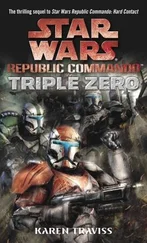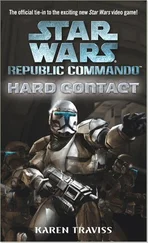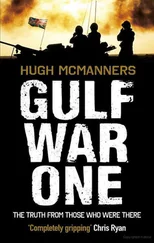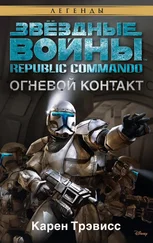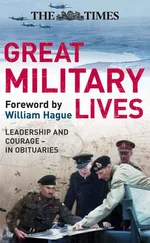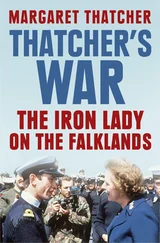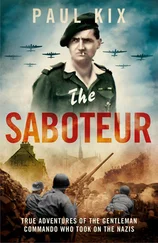Hugh McManners - Falklands Commando
Здесь есть возможность читать онлайн «Hugh McManners - Falklands Commando» весь текст электронной книги совершенно бесплатно (целиком полную версию без сокращений). В некоторых случаях можно слушать аудио, скачать через торрент в формате fb2 и присутствует краткое содержание. Город: London, Год выпуска: 2014, ISBN: 2014, Издательство: Nightstrike Publishing, Жанр: nonf_military, Биографии и Мемуары, на английском языке. Описание произведения, (предисловие) а так же отзывы посетителей доступны на портале библиотеки ЛибКат.
- Название:Falklands Commando
- Автор:
- Издательство:Nightstrike Publishing
- Жанр:
- Год:2014
- Город:London
- ISBN:978-0-992-81540-0
- Рейтинг книги:4 / 5. Голосов: 1
-
Избранное:Добавить в избранное
- Отзывы:
-
Ваша оценка:
- 80
- 1
- 2
- 3
- 4
- 5
Falklands Commando: краткое содержание, описание и аннотация
Предлагаем к чтению аннотацию, описание, краткое содержание или предисловие (зависит от того, что написал сам автор книги «Falklands Commando»). Если вы не нашли необходимую информацию о книге — напишите в комментариях, мы постараемся отыскать её.
Falklands Commando — читать онлайн бесплатно полную книгу (весь текст) целиком
Ниже представлен текст книги, разбитый по страницам. Система сохранения места последней прочитанной страницы, позволяет с удобством читать онлайн бесплатно книгу «Falklands Commando», без необходимости каждый раз заново искать на чём Вы остановились. Поставьте закладку, и сможете в любой момент перейти на страницу, на которой закончили чтение.
Интервал:
Закладка:
But the big danger of firing at night in unfamiliar territory, is of that first critical ‘navigators round’ being ‘lost’ in dead ground – as it could have fallen just about anywhere. If you apply a correction to bring it out from where you think it went, you might be moving it into some quite different area, and it may remain lost – and perhaps fall on something that wasn’t a target. I was not prepared to run this risk so near to Port Stanley, so our dead ground trace was prepared with great care.
After several hours, we’d found six identifiable enemy positions: a medium artillery battery, an infantry troop defensive position, a fuel dump, eleven helicopters in a field beside the hospital and two targets close to ourselves that we would register to use as protection if we were attacked, on the most likely enemy approaches into our position. In extremis , forward observers usually bring down fire on themselves, on the premise that you know it’s coming and can maybe survive, whereas it will certainly take the enemy by surprise.
Nick encoded our initial target list, which he transmitted to the SAAC (Supporting Arms Coordination Centre) on one of our PRC320 HF radios. As we were eating an ‘appetising’ breakfast of baked beans, bacon burger and biscuits AB washed down with a huge mug of hot, sweet coffee, two Harriers appeared overhead, circled behind the ridge, and then went, one behind the other, to make a bomb attack on Sapper Hill. The bombs landed some 500 metres east of the gun battery we’d located, and there was so much flak being fired up into the sky that a re-attack would have been very dodgy. I tried to speak to them on our UHF radio, but even if they did hear us, they were fully justified in ignoring a strange unauthenticated voice purporting to be in a place where no one was supposed to be.
They over-flew a second time, this time high above the maximum altitude of the enemy’s Roland anti-aircraft missile defence system, then exited north back out to Invincible .
We coded up another message to add to our target list, indicating where their bombs had exploded. The pilots would have been too busy avoiding flak and releasing their bombs to be certain where the bombs had landed. We also asked headquarters (the SACC – supporting arms coordination centre) for guidance about firing at the helicopters near to the hospital.
Beagle Ridge – First target list transmitted on 10 June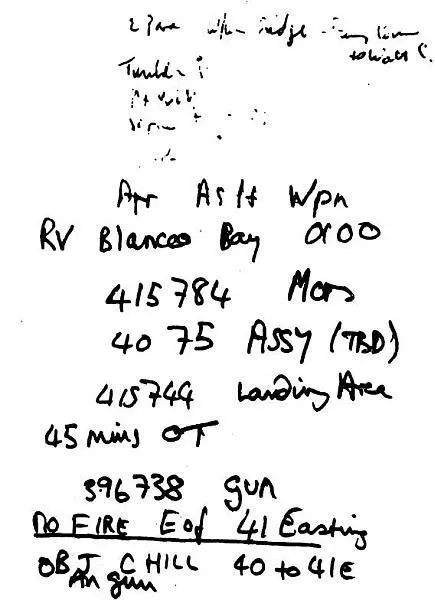
The first target list as transmitted by FO1 from Beagle Ridge on 10 June. This includes information on the effectiveness of a Harrier bomb attack and a query about opening fire on military targets near the hospital in Stanley.
I’d carefully measured bearings from the targets to points on the ground that I knew I’d be able to see at night. The streetlights of Port Stanley were an enormous help, and the silhouette of Sapper Hill and the curve of the Murrell River were also points from which locations could be determined. The brief flash of the shell detonating gives a quick burst of topographical information: the silhouette of a hill or ridge if it’s landed in dead ground, or a black-and-white image of the target which you have to try to ‘freeze’ in your memory to determine the necessary corrections.
The ships did have star-shell that would float down under a parachute and light up a very wide area. In theory, the high-explosive shells could then be adjusted onto the target whilst the star-shell was still burning. But the firing of the different types of ordnance on different bearings and elevations gave the gun end added complications. Although the computer easily managed the calculations, the benefits did not always justify the extra trouble. We could adjust onto point targets without star-shell, and secondly – and more importantly for us – the use of star-shell tells the enemy that an observer is adjusting the targets, whereas shells coming down at night and happening to hit targets, might be fired purely from map data or radar. Star-shell would also completely destroy our highly tuned night vision, which would take an hour or so to re-establish itself.
Our first night’s shooting was not entirely successful, but we did manage to set fire to fuel on the aviation-fuel dump to the west of the racecourse, as well as upsetting one of the gun batteries along Felton Stream, to the north-west of Sapper Hill. It was a confusing shoot, as the shells did not seem to obey the corrections I gave, and none of the usual remedies or ploys seemed to work. I estimated the error they appeared to have within their system, but they insisted nothing was wrong and were very unhappy when I told them they were to stop firing and leave the gunline.
I discovered afterwards that the ship had got her own position slightly wrong, her radar having surreptitiously shifted itself from the correct point (the Beacon ‘MIP’) to another datum point, which put her entire system out. As so often in the campaign, human common sense intervened with the technological complexities, and the next night the same ship was firing quite excellently.
Nick and I had, by this stage in the campaign, evolved a system for night firing. He would work the radio, establishing communications with the ship by morse and then going to voice as soon as she was close enough. We would start off with a target I knew would be easy to adjust, with as little dead ground as possible and well away from inhabited areas. I used my binoculars to scan the ground and measure the bearings and distances, using the graticules marked on the lenses for this purpose. Nick was constantly checking the tuning of the radio and referring to his code book, so his night vision was impaired by his using a heavily-masked torch. He would also use the nightscope to observe – also a light source, allowing my night vision to remain intact.
The firing took quite some time, as we were extremely careful and methodical. It was bitterly cold sitting out in the cutting wind, not being able to move to keep warm.
Tim crawled over from the rear sentry positions to see what we were up to. He casually mentioned it was his 21st birthday today (it had just turned midnight). What can you say? We both wished him many happy returns.
The gunline from which our ships fired was to the north, behind our OP position. We could hear the ships fire in the distance, then the air turbulence created by the shells as they screamed in over our heads. Once we were on target the ship would pump shells onto the enemy position, one every three or four seconds with a distinctive, hollow, booming explosion from far out to sea. We ate Rollos, bars of chocolate, and nuts and raisins from our ration packs like squirrels, in order to keep warm.
Our SBS colleagues further along the ridge had decided not to attempt to move south, and the SAS patrol that had met us on the LS had been recalled to Sir Lancelot. A Sea King took them all away, from a site well away from our ridge.
Although now totally isolated, we were very much anticipating the start of the final attacks on Port Stanley. But the security isolation system of only telling us what we needed to know and no more, meant that what was to happen and the date of the big push was a matter only for conjecture and great interest.
We spent the next day with binoculars and telescope giving ourselves eyestrain trying to assess the results of the previous night’s firing. Our picture of enemy dispositions was growing steadily. It’s surprisingly difficult to determine whether the infantry trench position you’re looking at is a platoon with some 30 members, a company of around 100, or even a battalion position with 600 and more. You have to observe what they’re doing, recognise people’s gait, body shapes and even faces (as they’re all wearing drab dark green), then actually count each one.
Читать дальшеИнтервал:
Закладка:
Похожие книги на «Falklands Commando»
Представляем Вашему вниманию похожие книги на «Falklands Commando» списком для выбора. Мы отобрали схожую по названию и смыслу литературу в надежде предоставить читателям больше вариантов отыскать новые, интересные, ещё непрочитанные произведения.
Обсуждение, отзывы о книге «Falklands Commando» и просто собственные мнения читателей. Оставьте ваши комментарии, напишите, что Вы думаете о произведении, его смысле или главных героях. Укажите что конкретно понравилось, а что нет, и почему Вы так считаете.

